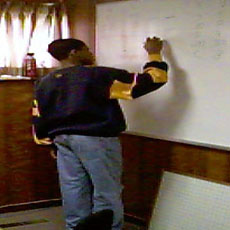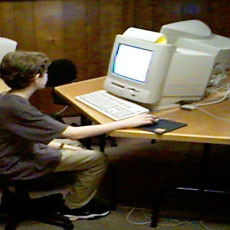|
This Math Explorations Club started from a coordinate plane game. The goal of the game is to guide a robot through a mine field using coordinates to command the robot. Natalie asked how to make the robot go to a certain point. Anne got a game where she could make the robot reach its destination in one step, and Veronica clicked on "New Game" until she could do the same. After playing the game for a while, students talked about the significance of coordinates. There were discussions of several important questions. What are coordinates? What are their uses in math and the rest of the life? How can one introduce coordinates? And so on. In the morning session, students explored different problems that can arise when one "forgets" to introduce scale or initial point (zero) on coordinate line and plane. Michelle and Robert noted that giving units is not enough to define coordinates, one also need to tell where zero is.
After that, the talk moved to a seemingly unrelated topic: "function machines." Students guessed what each machine does trying to put various numbers "into" the machine and observing the output. At this point, students used random function machine software. An interesting question to discuss was: How many numbers do you need to put into a machine to definitely determine its rule? For the type of functions given by the software (linear functions), Ben and Daniel quickly determined that it takes no more than two numbers. Maria pointed out that it may take one, in certain special cases. When two machines are connected, you get a composition of functions. There was a discussion on how the order of composition influences the result. Given two options for a salary raise: first double, then add 3, or first add 3, then double, which option should you choose? Tomas answered right away that the second option is better. Robert explained, on examples, why it is so. Amos added helpful remarks to the explanations.
The last question led to connecting function machines and coordinate plane topics for producing a most helpful combination: a graph of a function. Given two graphs representing salary raise options, students immediately saw which one they would prefer. "The red one is better," said Michelle (the graphs were drawn in different colors). The Club continued with discussion of graphs and their connections with stories. How can you tell by the graph of distance versus time which of several travellers was moving faster? Can you create a story that matches a given graph? Can you draw a graph based on your story?
|
|||
|
Please direct questions and comments about this page to WebMaster@shodor.org © Copyright 1998 The Shodor Education Foundation, Inc. |




